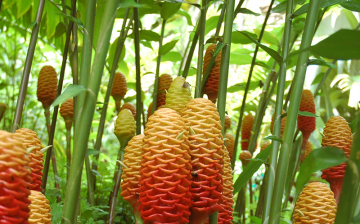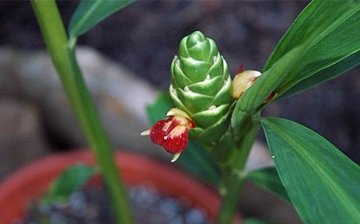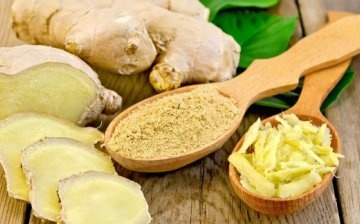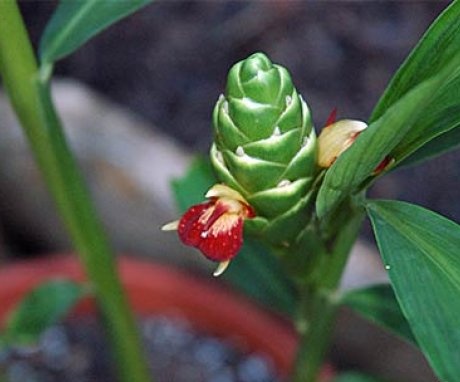What does the ginger plant look like and what is its use?
Ginger has a rich history that began over three millennia ago. The plant is perennial and resembles a reed with orchid flowers. In addition to useful properties, ginger has decorative properties and is able to revive any interior. Its sparse thin leaves do not shade the room, and the flower itself does not require special care.
In the store you can find dark and light ginger roots. Both of them belong to the same species, but the dark ones are pre-poured with boiling water, and the light ones are freed from the top layer of the peel and are treated with chemicals, which is why they lose some of their useful properties.
Content:
- Ginger - plant description
- How to propagate a ginger plant
- Providing plant care
- What properties does ginger have and its use?
Ginger - plant description
Ginger (Zingiber officinale) is a perennial herb rich in essential oils that have a specific and distinctive aroma. Ginger has thick rhizomes that are edible and have medicinal properties.
In appearance, ginger resembles sedge and its stem is covered with small scaly formations. The plant can grow up to two meters in height and blooms with brownish flowers gathering in inflorescences.
After flowering, fruits are formed - small boxes with small grains, which can be used for plant propagation.
Ginger comes from Southeast Asia, where it has been cultivated for many millennia. And during the Middle Ages, the plant became known in European countries, where it was actively used in food and in medicine. Today, ginger root is the most popular condiment. The plant is actively cultivated in Indian, Chinese, Japanese, Asian and Western European countries.
How to propagate a ginger plant
It should be remembered that the roots of the plant are quite sensitive to changes, therefore, ginger should be transplanted and propagated in the spring. There are two ways to propagate a plant: seed and by dividing the root. But since it is quite problematic to get high-quality seeds, the second method is mainly practiced.
Rhizomes are dug up and divided into smaller links, which are subsequently planted in wide and shallow containers in prepared soil (turf soil, humus, sand and garden soil in proportions 1: 1: 0.5: 0.5). Young shoots grow up to a meter and are covered with elongated lanceolate leaves.
Young strong rhizomes, which are distinguished by a golden color and an even silky surface, are most suitable for reproduction.
The root should be divided so that on each fragment there are several buds (eyes), and the sections are processed wood ashthat prevents decay. In order for the eyes to wake up faster, they should be stimulated. To do this, the roots are placed in a dark, cool place and kept for two to three weeks or soaked in warm water for several hours. Such procedures accelerate the emergence of sprouts.
Landing rules:
- In early spring, the prepared root fragments are planted in separate pots.
- The planting material should be placed horizontally with the eyes up. Dig in the roots should be no more than 1 cm.
- You can also place fragments on the surface of the soil without sprinkling, but in this case you will need to constantly spray the plant, not letting it dry out.
- Watering the ginger at this stage should be regular, but not abundant.
- The pots are covered with a plastic bag to prevent moisture evaporation and left at a temperature of at least 25 degrees.
The plant will germinate in about a month, so you should not be upset if the sprouts are not visible for a long time. The temperature must not be allowed to drop below 19 degrees, otherwise the seedlings may not appear. After the first shoots appear, ginger should be provided with proper care, which is quite simple.
Providing plant care
At home, ginger is cultivated as an annual plant. The provision of keeping conditions and the location of the plant affect the quality indicators of the soil and the condition of the ward himself. It must be remembered that this is a tropical guest and therefore he loves warmth and good lighting, but does not tolerate direct sunlight.
When borings appear, the pots should be freed from the film in order to prevent the plant from rotting and then take care of it, adhering to some rules:
- Irrigation. Watering should be regular so that the soil is constantly moist and loose. For these purposes, soft settled water at room temperature is suitable. About half an hour after irrigation, the excess water is drained from the pan. Otherwise, root rot may develop. In particularly hot weather, the humidity should be maintained by spraying. But at the same time, the leaves of the plant should not be allowed to be in the sun, otherwise burns will form. Also, the plant has a negative attitude towards drafts.
- Temperature conditions. The optimum temperature for a tropical inhabitant is 20-26 degrees. At this temperature, the plant is actively developing. If the plant is not dug up for the winter, then it should be provided with a temperature not higher than 15 degrees, at which the ginger will enter a dormant period.
- Fertilization. During the period of active growth, namely in spring and summer, ginger should be fed with liquid fertilizers twice a month. A solution is well suited as an organic matter mullein or bird droppings. At the end of summer, before applying top dressing, you need to decide for what purposes ginger is grown. If the goal is to get a crop of tubers, then you need to add potash dressings. If the plant is kept as a decor, then phosphorus.
- Harvesting. At the end of September, ginger actively sheds its foliage. At this point, watering should be minimized. After the plants dry out, the roots absorb the maximum of useful substances and they are dug up. Rhizomes peeled from the ground must be dried in the sun, having previously selected specimens suitable for planting. The planting material is sent for storage in a dark, cool and dry place, where the temperature will not rise above 4-5 degrees.
-
Diseases and pests. The plant is practically not damaged pests, because it exudes a specific smell and has the same taste. But in dry periods, it can be affected by the activity of spider mites. To cope with pest attacks, you can use a soap-alkaline solution or special chemicals.
If the plant is grown for beauty, then for the winter period ginger is left in a pot, but they provide cooler conditions, and watering and feeding are minimized. And with the arrival of spring heat, care is resumed. Subject to all conditions, the plant will release beautiful original flowers.
What properties does ginger have and its use?
Ginger root is used for the preparation of various products: powders, decoctions, infusions, essential oils. Powder and oil preparations are used for disorders of the digestive tract, for stimulating appetite, for diseases of the stomach and intestines (ulcers, gastritis).Also, ginger is effective in treating viral colds.
Ginger root is actively used in cooking fresh, dried and pickled. Before using the rhizome, it should be peeled. In eastern countries, the medicinal root is used as a seasoning, in Japanese - to improve digestion, it is used in between meals. The rhizome of the plant is similar to Jerusalem artichoke, but in terms of taste, these tubers are strikingly different. Ginger tastes like peppery lemon with a spicy aftertaste and specific aroma.
According to the useful properties of ginger rhizomes, you can safely put in the first rows:
- Numerous studies, including in mice, have shown that substances contained in rhizomes are able to protect against cancer. They are, of course, unable to cure, but as a preventive measure and as an additional medicine, they show their best side. To do this, it is enough to add the dried, powdered root to food or drinks. In addition, such a seasoning will add piquancy and sophistication to dishes, and also diversify the daily diet with oriental notes.
- It is also important that ginger stimulates appetite and improves digestion.
- And the fat burning properties make it indispensable for dietary nutrition for weight loss. Because the food that enters the body with such a seasoning is digested faster, so extra pounds do not accumulate.
Fresh plant roots can be frozen by fine grating or dried. But dried rhizomes must be soaked in water before use. This root is more concentrated and one teaspoon of dry root is equal to a tablespoon of fresh.
An interesting fact is that if you put ginger in gloves or socks during the cold season, it will keep warm throughout the day.
Ginger contains up to three percent of essential oils, the main component of which is alpha and betatsinhyberins (about 75-80%).
Growing a ginger plant does not take much effort. The main thing is to decide in advance what to cultivate this representative of the flora: for the sake of rhizomes or decorativeness - care in winter will depend on this. In any case, the presence of a tropical guest in an apartment or house brings a lot of positive emotions, good mood and good health with strong immunity.
More information can be found in the video:

















I often use the root of this plant in cooking meat dishes, but I like pickled ginger less. All attempts to grow ginger myself from sufficiently fresh roots purchased on the market have failed.
It seems to me that this is still an exercise for masochists. It grows in Australia (for example). Where is Australia and where is Siberia. At the same time, it does not differ in any special decorative properties - so why?